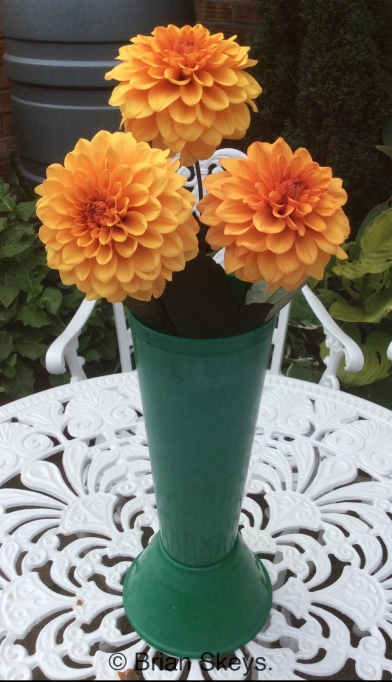Growing Dahlias has become popular again within the last 15 years or so, some credit the late Christopher Lloyd at Great Dixter with their revival.
I grew up next door to my maternal grand parents and there was a large garden producing almost all of our food. A vegetable garden and orchard with chickens, pigs and bees kept my grandparents and parents busy, we were ‘encouraged’ to help with the weeding along with having our own little plot.
Besides growing food for the table my grandparents used to show an array of produce in all the local shows. Their pride and joy was the Dahlia cutting bed (how ‘today’ was that!) providing both flowers to sell and for show.
This picture below shows them standing among the Dahlias with one of their prize winning cups.

From the beginning I have grown Dahlia’s here in Our Garden@19, partly due to nostalgia, partly inspiration from visiting Great Dixter and reading Christopher Lloyd’s books.
I use them in a simple rotation, in the raised beds edging the patio and following on in the space, occupied by Tulips, Wallflowers and Forget-me-Nots. I lift and store the Tulips in the greenhouse during the summer when the Dahlias are ready to go into the garden. The bulbs worth keeping, along with any new ones, are planted in November after lifting the Dahlias to store in the green house.
The Dahlias below are the ones in the garden this year. One new one is ‘Mexican Star’, a hybrid between Chocolate Cosmos and a Dahlia. It is darker in colour than the photograph and is reputed to smell of chocolate, I can confirm it does. I wrote about purchasing the tubers at Chocolates and Flowers
The raised beds are also planted with other tender annuals such as Tagetes patula. I purchased the original seed from Great Dixter, it is their own strain selected for height and will grow to between 3 to 4ft…
..also with Cosmos…
and Calendula officinalis…

All of the above have been grown from own saved seed, the yellow Cosmos seed originally came from Amelia
I have copied below an updated version of a Dahlia Fact Sheet I produced for the Black Pear Gardening Club website. I hope you find it interesting and perhaps useful.
DAHLIA FACT SHEET.
Named after Dr Anders Dahl.
There is a Tree Dahlia that flowers at Christmas.
Dahlia Imperialis grows up to 18ft high.
Open centred Dahlias are better for wild life.
Propagation.
Dahlias can be grown from own saved seed, but they don’t come true to type.
Cuttings can be taken in the spring when growth starts. You need to cut a small amount of tuber with each shoot, you can apply rooting hormone, pot up and keep in a propagator or put poly bag over pot. You may need to spray mist in the first few days.
When there are signs of growth, pot on to individual pots when needed.
Remove central stem from cuttings to produce more stems.
If you have a big tuber you can divide it. Wait until you can see new growth and then cut into sections with at least one shoot. Dress any cuts with yellow sulphur dust and then pot up.
Lifting and storing Dahlias.
Lift after frost has blackened tops, cut off tops, shake most of the soil off and place in frost free environment upside down to dry. Dust tubers with yellow sulphur powder, especially on any damaged tubers, before putting in boxes of compost right way up with the stems just showing.
I store in boxes lined with newspaper in a mix of cheap compost and vermiculite (approx 10:1). A cheap form of insulation is polystyrene tiles placed under and around the boxes.
In very cold weather you can also throw over horticultural fleece but don’t use bubble wrap over the top, as this does not allow any air into the box and the tubers could rot. Bubble wrap is ideal for lining greenhouses to provide extra insulation in winter. Check during the winter and if the compost becomes too dry, give a light watering on a frost free day. Also remove the fleece to allow fresh air to circulate or mould can develop.
Around mid March start to apply some water to encourage growth.
In April I put the tubers into big pots with good compost to give them a good start before
moving them outside on sunny days to harden off before planting out in late May – June. They are well grown by the time they are planted into the garden, which helps to reduce slug damage.
If you have free draining soil and wish to leave in the ground cut back after the first frost and provide an insulating mulch of compost or bark. You will need to apply slug protection early in the spring.
Pest and Diseases.
Virus – yellowing of the plant. (Destroy plant don’t compost.)
Earwigs – only a problem if growing for show. My Grandfather use to put inverted flower pots stuffed with folded newspaper on canes by each Dahlia he would then shake the earwigs out into a bucket and feed to the chickens! If you want to use as cut flowers, cut the Dahlia flower, hold upside down and shake vigorously to dislodge insects before taking inside the house.
Slugs – use any method that you find works. I use organic slug/snail pellets and nematodes in the garden. (Nematodes don’t work against snails).
Feed.
Dahlias are heavy feeders; good garden compost or old farm yard manure can be incorporated into the planting hole along with a high potash fertiliser, Vitax Q4, a Rose fertiliser or for organic gardeners Blood, Fish and Bone. A second application will be needed later in the growing season to keep them flowering. If grown in pots use a slow release fertiliser and some water retaining gel.
Except for dwarf varieties, Dahlias will need staking. The Great Dixter method, for individual plants, is to tie a piece of string to a stake and then loop the string around each of the main stems and tie back to the stake. This prevents that bunched up look you see when string is tied around the whole plant and allows each stem some individual movement.
Dead head during the flowering period and you will have a good display all summer.
Over time Dahlias have come and gone, here in Our Garden@19, the one constant presence is my favourite ‘David Howard’. It is a robust Dahlia, producing large tubers from which to propagate.
I realise orange is not to every ones taste in a flower, I recently read it described as ‘Butterscotch’, however I think along with its dark foliage it has the ‘Wow’ factor.

Not quite up to Grandparents standard, third prize in our village show. (Apparently the stems are too short).
Do you grow Dahlias and have a favourite one?


















It’s funny but I used to hate dahlias but am now beginning to think some of them look rather attractive. I shall bookmark this page and return to it when our new garden is ready to be planted. Fashion is a fickle thing.
LikeLike
I shall look forward to seeing your new garden. As I am sure you realise Anne, I am at the cutting edge of fashion!😀
LikeLike
I have grown a couple of Dahlias in my previous garden, and was looking forward to including them next year. Your article summarises their cultivation very clearly….thanks Brian.
LikeLike
Thanks Noelle.
LikeLike
These are all beautiful, Brian!
LikeLike
Thank you Pete.
LikeLiked by 1 person
My sister gave me seeds of “Yankee Doodle Dandy” so I just had to grow them with a name like that. They are various colours and I am enjoying my Dahlias which survive marvelously well despite the heat and dry in my garden. You have a beautiful wide collection, the garden must look so good at the moment. I am glad you are enjoying your Cosmos sulphureus. Amelia
LikeLike
Thank you Amelia, are you able to leave the tubers in the garden over winter?
LikeLike
I never lift the tubers and everything comes up – and more. I do not get round to dead heading as much as I should and some have self-seeded.
LikeLike
We grow a small number of dahlias. I rather like th singles and the pom-poms.
LikeLike
You have reminded me Sue I forgot about the little red Pom Pom that I have growing in the front garden!
LikeLike
Beautiful cultivars, Brian. This year, I used tomato cages over my dahlias and they worked great. I curbed slugs with copper flashing, but now have problems with earwigs and Japanese beetles. It is always something, isn’t it?
LikeLike
Thanks Eliza. I haven’t heard of tomato cages over here, you can though buy different plant supports, which I do also use with my Dahlias and other plants needing support.
LikeLiked by 1 person
This was a really interesting post, Brian, which added to my knowledge of dahlias; I have copied the section on Dahlia Facs for future reference. Is there not something safer than sulphur to use these days and how easy is it to acquire, anyway? I have noted the taller tagetes and will look out fr that – unless you have some spare see, that is… 😉
LikeLike
Hi Cathy,
The sulphur powder is still widely available in garden centres, it is used to prevent rot when storing corms, bulbs and tubers. I would hope to save seed again this year Cathy, you are welcome to some.
LikeLike
I guess I assumed there would be alternatives these days or perhaps it’s safer handling sulphur than I might have expected 😉
LikeLike
I don’t have any problem useing it Cathy, you could wear a dust mask to be on the safe side.
LikeLike
Thanks for this, Brian
LikeLike
👍
LikeLike
I lost all of my rather old dahlias and have started restocking this year, so far with three of the “Bishops” and three cactus types. I’ll aim to add another six next year. Must look out for “David Howard”. Nowt wrong with that orange against the dark foliage. I hadn’t heard of the “Dixter method” before, I just tie the strongest stem to the stake and let the rest take their chance with a bit of help from surrounding planting. If I space things out a bit more next year, I’ll certainly try the looping approach.
LikeLike
You don’t often see David Howard for sale. The National Dahlia collection in Cornwall is a good source, they supply by mail order as young plants in the spring. I have used them very successfully in the past.
LikeLike
I intend to remember your description of the Dixter method, as it seems like an excellent option for a number of plants.
What a lot of beauty from the dahlias – I think it’s a shame they ever went out of fashion, but it’s good they are getting attention again! (Having said which, I have no intention of trying them here till I’ve exhausted the options of plants more likely to succeed… 😉 ) Thinking about your post, I realize that I grow roses mostly because of my grandmother. 🙂
LikeLike
I am convinced grandparents have great influence regarding gardening. We are trying to do our bit.
LikeLike
I love the photo of your grandparents with their Dahlias. I add to my Dahlia collection every year, although I am not always successful with overwintering the tubers. One Dahlia I have successfully overwintered is the tree Dahlia – Dahlia imperialis. I have never got one to flower though! I think I will add David Howard to my collection next year. With my track record, a robust Dahlia would definitely be a good choice.
LikeLike
Thank you Sarah, I was thinking reading your comment, I wonder what they would make of blogging and the modern world. I hope you can find David Howard.
LikeLike
What a wonderful collection! And I agree that Butterscotch has the wow factor. A real beauty.
LikeLike
Great article, thanks, I’ll cut and keep for reference. I do like Dahlias but as I bought mine a few years ago in Tesco I don’t know the variety. The packaging said orange on one and purple on the other and, so far as that went, they were correct. They both grow tall, about 5 feet.
LikeLike
Thank you, at least the description was correct!
LikeLiked by 1 person